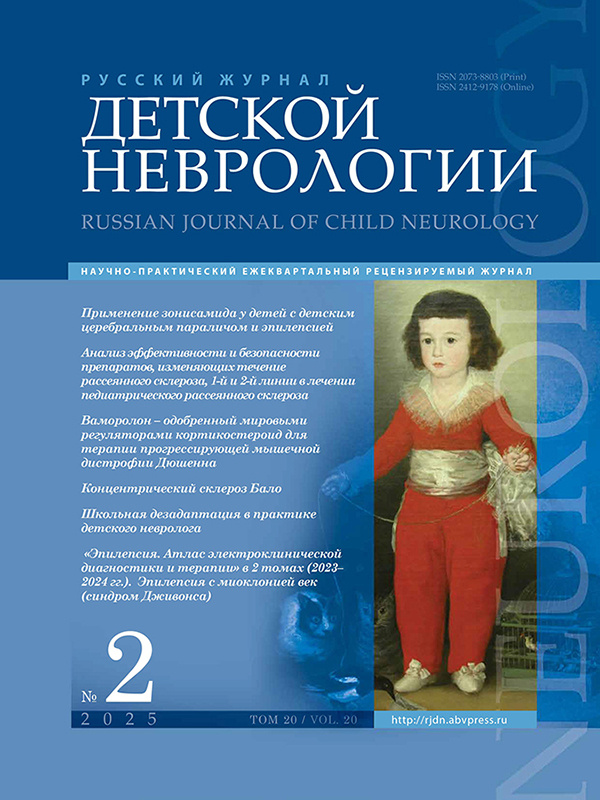Phenobarbital in HECW2-associated epileptic encephalopathy: unexpected clinical efficacy
- Authors: Batyrov M.A.1, Per Н.2, Mamytova E.M.3, Nurbekova U.A.4
-
Affiliations:
- International University of Kyrgyzstan
- Erciyes University
- Salymbekov University
- Radiology Diagnostic Center “URFA”
- Issue: Vol 20, No 2 (2025)
- Pages: 71-77
- Section: CLINICAL OBSERVATIONS
- Published: 04.08.2025
- URL: https://rjdn.abvpress.ru/jour/article/view/523
- DOI: https://doi.org/10.17650/2073-8803-2025-20-2-71-77
- ID: 523
Cite item
Full Text
Abstract
Mutations in the HECW2 gene cause severe neurodevelopmental disorders, including epileptic encephalopathy, psychomotor delay, and drug-resistant seizures. The article presents a clinical case of a 2-year-old girl with epilepsy onset at 3 months, developmental regression, hypotonia, and dysmorphic features. Genetic testing revealed a heterozygous missense mutation in the HECW2 gene (c.3988C>T, p.Arg1330Trp). Electroencephalogram showed generalized, multifocal epileptiform discharges, and magnetic resonance imaging revealed external hydrocephalus. In treatment against the background of the ineffectiveness of carbamazepine, valproate and levetiracetam, significant seizure control was achieved with phenobarbital in combination with levetiracetam. This case highlights the challenges in treating HECW2-related epilepsy and suggests phenobarbital as a potential option for refractory seizures.
About the authors
M. A. Batyrov
International University of Kyrgyzstan
Author for correspondence.
Email: dr.maksat@mail.ru
ORCID iD: 0009-0003-0533-5264
Maksatbek Adilbekovich Batyrov, Department of Special Clinical Disciplines
17A/1 Lva Tolstogo St., Bishkek 720001
KyrgyzstanН. Per
Erciyes University
Email: fake@neicon.ru
ORCID iD: 0000-0001-9904-6479
Faculty of Medicine
1 Turhan Baytop St., 38280 Тalas/Kayseri
TurkeyE. M. Mamytova
Salymbekov University
Email: fake@neicon.ru
ORCID iD: 0000-0002-4322-5555
Department of Clinical and Morphological Disciplines
3 Fuchika St., Bishkek 720054
KyrgyzstanU. A. Nurbekova
Radiology Diagnostic Center “URFA”
Email: fake@neicon.ru
ORCID iD: 0000-0001-9671-7564
137 Toktogula St., Bishkek 720005
KyrgyzstanReferences
- Sivkova S.N., Mukhin K.Yu., Zaykova F.M. Efficiency of treatment of focal forms of epilepsy in children with antiepileptic drugs of different generations. Zhurnal nevrologii i psikhiatrii im. S.S. Korsakova = S.S. Korsakov Journal of Neurology and Psychiatry 2011;111(6):42–8. (In Russ.). doi: 10.17116/jnevro20111116242-48
- Acharya A., Kavus H., Dunn P. et al. Delineating the genotypic and phenotypic spectrum of HECW2-related neurodevelopmental disorders. J Med Genet 2022;59(7):669–77. doi: 10.1136/jmedgenet-2021-107774
- Berko E.R., Cho M.T., Eng C. et al. De novo missense variants in HECW2 are associated with neurodevelopmental delay and hypotonia. J Med Genet 2017;54(2):84–6. doi: 10.1136/jmedgenet-2016-104104
- Cherubini E., Di Cristo G., Avoli M. Dysregulation of GABAergic signaling in neurodevelopmental disorders: targeting cation-chloride co-transporters to re-establish a proper E/I balance. Front Cell Neurosci 2022;15:813441. doi: 10.3389/fncel.2021.813441
- Ellison J.W., Rosenfeld J.A., Shaffer L.G. Genetic basis of intellectual disability. Ann Rev Med 2013;64(1):441–50. doi: 10.1146/annurev-med-042711-140053
- Halvardson J., Zhao J.J., Zaghlool A. et al. Mutations in HECW2 are associated with intellectual disability and epilepsy. J Med Genet 2016;53(10):697–704. doi: 10.1136/jmedgenet-2016-103814
- Heide E.C., Puk O. et al. A novel likely pathogenic heterozygous HECW2 missense variant in a family with variable expressivity of neurodevelopmental delay, hypotonia, and epileptiform EEG patterns. Am J Med Genet Part A 2021;185(12):3838–43. doi: 10.1002/ajmg.a.62439
- Krami A.M., Bouzidi A., Charif M. et al. A homozygous nonsense HECW2 variant is associated with neurodevelopmental delay and intellectual disability. Eur J Med Genet 2022;65(6):104515. doi: 10.1016/j.ejmg.2022.104515
- Marrus N., Hall L. Intellectual disability and language disorder. Child Adolesc Psychiatr Clin N Am 2017;26 (3):539–54. doi: 10.1016/j.chc.2017.03.001
- Miyazaki K., Ozaki T., Kato Ch. et al. A novel HECT-type E3 ubiquitin ligase, NEDL2, stabilizes p73 and enhances its transcriptional activity. Biochem Biophys Res Commun 2003;308(1):106–13. doi: 10.1016/s0006-291x(03)01347-0
- Nakamura H., Uematsu M., Numata-Uematsu Yu. et al. Rett-like features and cortical visual impairment in a Japanese patient with HECW2 mutation. Brain Dev 2018;40(5):410–4. doi: 10.1016/j.braindev.2017.12.015
- Niklison-Chirou M.V., Steinert J.R., Agostini M. et al. TAp73 knockout mice show morphological and functional nervous system defects associated with loss of p75 neurotrophin receptor. Proc Natl Acad Sci USA 2013;110(47):18952–7. doi: 10.1073/pnas.1221172110
- Rodríguez-García M.E., Cotrina-Vinagre F.J., Bellusci M. et al. First splicing variant in HECW2 with an autosomal recessive pattern of inheritance and associated with NDHSAL. Hum Mutat 2022;43(10):1361–7. doi: 10.1002/humu.24426
- Ullman N.L., Smith-Hicks C., Desai S., Stafstrom C. De novo HECW2 mutation associated with epilepsy, developmental decline, and intellectual disability: case report and review of literature. Pediatr Neurol 2018;85:76–8. doi: 10.1016/j.pediatrneurol.2018.03.005
- Wright C.F., Fitzgerald T., Jones W. et al. Genetic diagnosis of developmental disorders in the DDD study: a scalable analysis of genome-wide research data. Lancet 2015;385(9975):1305–14. doi: 10.1016/S0140-6736(14)61705-0
- Yang A., Walker N., Bronson R. et al. P73-deficient mice have neurological, pheromonal and inflammatory defects but lack spontaneous tumours. Nature 2000;404(6773):99–103. doi: 10.1038/35003607
- Yanagishita T., Hirade T., Shimojima Yamamoto K. et al. HECW2-related disorder in four Japanese patients. Am J Med Genet A 2021;185(10):2895–902. doi: 10.1002/ajmg.a.62363
Supplementary files






